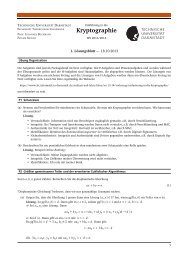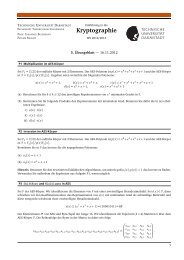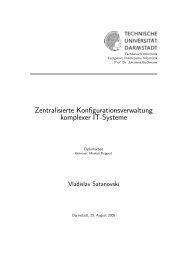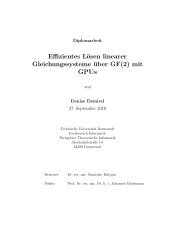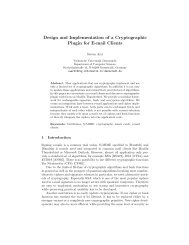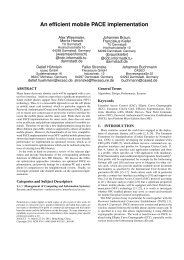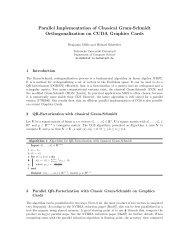Merkle Tree Traversal Techniques - CDC
Merkle Tree Traversal Techniques - CDC
Merkle Tree Traversal Techniques - CDC
You also want an ePaper? Increase the reach of your titles
YUMPU automatically turns print PDFs into web optimized ePapers that Google loves.
store the node values included in the authentication path of the first leaf. In the<br />
second step we store P( n h,0)<br />
for every h= 0,1,..., H−<br />
1 and we say Stack h<br />
P n h,0<br />
. In the third step we simply store and output<br />
the root value. Here is the algorithm itself:<br />
contains only the value ( )<br />
Algorithm 3.1: Key Generation and Setup<br />
1 Initial Authentication Nodes: For each h { 0,1,..., H 1}<br />
Calculate Authh P( nh,1)<br />
= .<br />
2 Initial Next Nodes: For each h { 0,1,..., H 1}<br />
with the value of the sibling of h<br />
17<br />
∈ − :<br />
∈ − : Set up Stack h<br />
Auth - ( h,0)<br />
P n (left nodes).<br />
3 Public Key: Calculate and publish tree root value Pn ( root ) .<br />
After this phase of the classic <strong>Merkle</strong> tree traversal we start the next one with<br />
already computed leftmost nodes and their siblings.<br />
3.3.2 Output and Update: This is the phase in which we output every leaf value<br />
together with the authentication path of the corresponding leaf (we use<br />
LEAFCALC for the leaf values computation). For the purpose we have a<br />
counter leaf which starts from zero and is increased by one every round, thus<br />
denoting the index of the current leaf (we run the algorithm once for each leaf<br />
of the tree). The outputs are made in the beginning of every round. After the<br />
output is made we come to the refreshment of the authentication nodes (the<br />
leftmost nodes in the very beginning of the traversal). The idea is that we shift<br />
these authentication nodes to the right when they are no longer needed for<br />
upcoming authentication paths. The authentication node at height h<br />
( h= 0,1,..., H−<br />
1)<br />
needs to be shifted to the right if 2 h divides leaf + 1<br />
without remainder. The new authentication nodes take their values from the<br />
stacks, created in the key generation part. After Auth h is changed, we alter<br />
also the contents of Stackh by using the Stackh. initialize and Stackh. update<br />
methods, thus making further modifications possible. We notice that at round<br />
1 2 h<br />
h h<br />
leaf + + the authentication path will pass through the ( leaf + 1+ 2 ) /2 -<br />
th node at height h . The startnode value of the initialization process (and<br />
future Auth h ) comes from the 2 h leaf values, starting with the leaf with index<br />
( )<br />
h h<br />
leaf + 1+ 2 ⊕ 2 , where ⊕ is a bitwise XOR. Now we present the exact<br />
algorithm:





